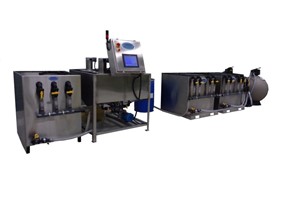Automated wastewater treatment systems play a crucial role in helping manufacturers adhere to EPA and local standards, thereby minimizing the expenses associated with treatment, labor, and disposal. Industrial facilities are obligated to meet stringent effluent requirements outlined in the Clean Water Act. Non-compliance can lead to substantial fines.
The nature of wastewater generated varies based on the industry, encompassing elements like suspended solids, heavy metals, and organic compounds. According to the Clean Water Act, the EPA has identified 65 pollutants as "toxic pollutants," with 126 specific substances marked as "priority" toxic pollutants. To ensure compliance, many facilities opt for wastewater treatment systems that effectively remove contaminants, enabling legal discharge into sewer systems or potential reuse.
However, conventional wastewater treatment methods are intricate, involving multiple steps, various chemicals, and substantial labor. Even supposedly automated processes often necessitate manual monitoring by technicians, overseeing tasks such as mixing, separation, and chemical addition. Despite these efforts, the treated water may still not meet mandated requirements.
An alternative is hauling away industrial wastewater, but this proves exorbitantly expensive. In contrast, treating industrial wastewater at its source is a more cost-effective solution. Treated effluent can be discharged into sewers, and treated sludge can pass a TCLP test, allowing it to be disposed of as non-hazardous waste in local landfills.
Thankfully, compliance with EPA and local wastewater regulations has been simplified with the advent of fully automated wastewater treatment systems. These systems not only consistently meet regulatory requirements but also significantly cut down on treatment, labor, and disposal costs, especially when using appropriate Cleartreat® separating agents.
In contrast to labor-intensive multiple step processes, automated wastewater treatment can help to streamline production, usually with a one-step process, while lowering costs at industrial facilities.
Cost-Effective, Automated Wastewater Treatment
Automated wastewater treatment systems offer a solution that eliminates the need for manual equipment monitoring while ensuring compliance with EPA and local regulations. These systems effectively separate suspended solids, emulsified oil, and heavy metals, encapsulating contaminants and producing easily de-waterable sludge within minutes. The treated water is then further processed using de-watering tables, bag filters, filter presses, or rotary drum vacuums before being discharged into sewer systems or filtered for reuse in industrial processes.
These automated systems come in various configurations, including manual batch processors, semi-automatic, and fully automatic setups. They can even be designed as closed-loop systems for water reuse or for producing legally dischargeable effluent suitable for sewer systems. In many cases, modifying existing industrial wastewater treatment systems can be a more expedient and cost-effective solution than installing an entirely new customized system. However, each wastewater treatment solution must be tailored to the specific industry and application, considering the unique composition of the wastewater, local regulations, volume to be treated, and facility size restrictions.
An example of a successful implementation of an automated wastewater treatment system involves a large, corrugated manufacturer that processes millions of square feet of corrugated packaging daily. This manufacturer improved its wastewater treatment efficiency by utilizing an EconoFlow fully automated wastewater system along with Cleartreat separating agents from Sabo Industrial Corp. The system, equipped with sensors and remote monitoring capabilities, effectively treats wastewater generated from flexographic printing presses washdowns, which use various inks in the manufacturing process.
Crucial to the effectiveness of these automated systems is the use of specialized separating agents like ClearTreat, which contains bentonite clay. Bentonite clay has a large specific surface area and a negative charge, making it highly effective for adsorbing and removing heavy metals, organic pollutants, and other contaminants from wastewater. Unlike polymer-based products, bentonite-based agents encapsulate toxins effectively, preventing their leaching back into the treated water. This one-step treatment significantly reduces process and disposal costs.
In summary, today's automated wastewater treatment systems, coupled with advanced Cleartreat separating agents, provide manufacturers with a convenient and cost-effective alternative for ensuring compliance with local regulations and the EPA. Although these systems entail an initial cost, they require minimal attention and are often more economical than facing fines or resorting to expensive wastewater hauling methods.
Dive deeper into the subject matter – click here to learn more!














